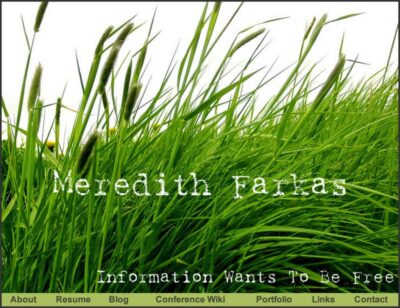In the Spring, I taught a class for San Jose State University on social software in libraries. Last week, I received both the student review of my teaching (which is anonymous) and the peer review of my teaching by a permanent faculty member at SJSU. I was beyond pleased by the comments and by my ratings, which were so much higher than the median for the program and the University. I’d thought the course went well, but to hear it from the students and from an experienced faculty member meant so much to me. It was risky to try new technologies and a new model for course delivery when you’ve never even taught before. It’s nice to know I did it right, especially since I’ll be teaching the class again in a week!
When I was asked to teach, I really wasn’t sure how things would go or if I would be cut out for teaching online (or teaching at all), but it ended up being one of the best experiences I’ve ever had. I loved designing the learning experience and I loved working with the students. It was so rewarding to watch them learn, reflect on their experiences, and develop new skills. I was blessed with a fantastic group of students. They were bright, enthusiastic critical thinkers, and I was blown away by the insightful conversations that took place in the classroom.
I’d say the most difficult part of the class was grading assignments. I made my life a lot easier by creating structured rubrics that forced me to be very consistent in how I graded each student, but still, it was hard to give people bad grades. While no one got a bad final grade in the class, I think I may have been a tougher grader than some of them were accustomed to. But I also gave them lots of comments on their papers, offering lots of constructive criticism. So hopefully they at least understood why they got the grade they did.
I owe a great deal of the success of the class due to the encouragement and support of Debbie Faires and Linda Main at SLIS. Both were 100% supportive of my abandoning Blackboard for Drupal, which allowed me to really design the course much in the way we did with Five Weeks to a Social Library. I think it made the classroom more flexible, participatory and egalitarian. It also allowed me to integrate the discussion elements of the class (the blogs) into the classroom instead of having students each create their own blog in various places (thereby scattering the discussion). Had I used Blackboard, I think the experience would have been quite different (less flexible, more fragmented).
I thought I’d write a little about some of the things that went right with my course, things that were not successful, and what the pros and cons are of using Drupal as a course management system.
Things that were a big hit:
Blogging = reflective learning – I’d say blogging was of critical importance to the success of the course. We covered a lot of material in the class over 15 weeks, and it can be easy to go on auto-pilot and miss absorbing much if you don’t really think about what you’re learning. However, each week, students had to reflect on their thoughts about and experiences in using the technologies. That reflection is so critical to learning, because it forces you not just to read and regurgitate but to think about its meaning and significance. It was also helpful that students were required to respond to other students’ reflections, because it helped them to challenge and support each other as well as better understanding other points of view.
Conversation = Connection – In the classroom, what you see on the front page are the most recent blog posts from all of the participants (not just me). Putting the conversation at the forefront in the classroom really makes that the most important element of the course. It’s not just an afterthought like some discussion boards feel like in courseware. Making those conversations central, I think, leads to better conversations. And those conversations lead to students getting to know each other better. Students seemed much more interested in each other than I remember from my classes at FSU. Also the level of conversation going on was so much deeper than I found when I was a student. People really had insightful things to say and challenged/supported each other in the comments on their posts.
One student commented on the level of engagement in the class:
This has been one of my favorite classes that I’ve taken in the SJSU slis program. I don’t think it’s all because of the material, either. It’s the connectedness that’s made it different. When I feel more connected to the class and the people in the class, I feel more engaged, and when I feel more engaged, I do better work and learn more. Funny how that is ☺
Experiential learning – In addition to reading about social software, students were also exploring social software through 10 discovery exercises. Exercises included creating podcasts and screencasts, editing wikis, creating Facebook or MySpace profiles, building a Yahoo! Pipe, displaying/filtering/mixing RSS feeds on a web page and more. It’s one thing to read about MySpace profiles, another thing entirely to try and create one. Students learned a lot from actually doing and not just reading. In addition, while the activities were challenging, students really felt a sense of self-efficacy when they found they could do it:
What really surprised me more than anything about a specific tool we’ve learned this semester is my own ability to learn these applications and put them to use. Every week it seemed I was saying to myself something along the lines of “Oh man, I have to learn how to make a podcast today. I don’t even know what a podcast is!” and then, sure enough, the next day I had learned what it was, how to create one, and how to teach others how to make one.
In addition to that feeling of self-efficacy, I think the read/experience/reflect cycle each week made learning much stickier:
My experience in this course was practical and hands-on. Instead of reading about concepts relating to library and information science and discussing them, we read about concepts, applied them in a real-life setting, and then shared our experiences. I really liked the dialogue we developed as a class, and all of my classmates had thoughtful insight and suggestions to share. I am thankful to have been given an opportunity to practice using different types of social software so that I can make future recommendations according to personal experience. I am also thankful I was forced to use applications I would not have used otherwise because now I am not intimidated by them.
Fantastic!
I know some people have argued that classes that teach about social software are frivolous and trendy, but I strongly believe that this class taught students so much more than just how to use social software. It taught them to not be afraid to try out technologies they’re unfamiliar with and to bang things with rocks to get them to work. It taught them how to evaluate new technologies and visualize how they can be used in different settings that they may not have been intended for. It taught them how to plan for and manage new technologies in libraries. It taught them how to use technologies for instruction. It taught them how to better collect knowledge internally in libraries. It taught them how to “sell” new technologies to colleagues and administrators. And much more. One student commented on the timeliness of the topics, but the timelessness of the lessons learned: “I imagine that someday soon the stuff from this class will be ‘so last week’ but it has gotten me into the practice of trying new stuff and trying to use it for other purposes.” Developing that mindset, I believe, is critical to being a successful librarian in the 21st century. And while other classes could teach that mindset, there certainly weren’t any that fostered that in me when I was at FSU.
Guest speakers – I was very keen on exposing my students to librarians who are successfully using social technologies in libraries, so for the synchronous web conferences we had during class, I invited librarians to speak with my students about their work and views on social technologies. I had three speakers from different library types (public, academic, corporate) who had implemented a number of different social tools in their libraries and had interesting insights (thanks Chad, Dan and Vicky!). Students commented that they really loved hearing from other librarians who could offer practical advice. This time around, I plan to have six speakers, so students can get even more perspectives!
Transparency – There was transparency at a number of levels with this course. First of all, there was my transparency with students. I was very open with my students in explaining my reasoning for doing things and was very clear that I would be willing to make changes to the course if students told me that things weren’t working. It was my first time teaching a for-credit course online, and I wanted to make sure that I was giving students the best experience. If I wasn’t, I really did want to know and would have been happy to make changes. Luckily, it seems that the experience was enjoyable for them. The other level of transparency was the course itself. Instead of being locked into online courseware, this was on the open web. The students could access all of the lectures and assignments without having to log in. In addition, anyone could see what they wrote, making their use of social software tools much more in-line with the reality of using them in libraries. It was great having it be so open and we did have a few people comment from outside of the class. The same will be true for my upcoming class, so if you’re interested in taking part in some pretty interesting conversations about social software, please pop by.
Drupal is so much better than Blackboard for anyone who is keen on an easy-to-access, easy-to-follow, streamlined experience. The content can be organized flexibly to best meet the needs of students. It’s easy to find content by a specific author or about a specific topic. A number of students commented on how much they loved being able to follow the class using RSS:
Drupal was much better for me than Blackboard. Finding old items and keeping track of threads was easy. And being able to keep track of the class through RSS was just fantastic. It was also interesting to see the occasional comment from someone outside the class. This was a very open and transparent class, just the exact sort of environment that social media creates.
Things that missed the mark a bit:
Social bookmarking – I wanted the students to explore other resources out there since the readings I chose and my views espoused in lectures were not the only points of view on the topics covered. So I required students to bookmark three resources/articles/etc. each week and tag them with the course tag. I had a page where all of the bookmarked content was aggregated, but I don’t think students looked at what other people were bookmarking and it became more of a chore to do each week than a means to an end. This time, I’m going to have students find one resource/article/etc. and write a brief blog post about it. I think this way it will feel more integrated into the course and will be more than just a title on a list for students. They’ll still use del.icio.us for a discovery exercise one week, but I hate to make anything in the class just feel like busywork.
Forums – I’m not going to say that these were a total dud, but they definitely didn’t get used much. Since the class is so open to the public, I wanted to give students a space that was only accessible to people in the class. So if students had questions, needed help, or just wanted to discuss something in a more private forum, they could do that. The forums were only accessible to me and the students, but they actually got used very rarely and I found that students tended to email me about things rather than using them. I still plan to have Forums for my class in the Fall, since you never know how a different group might use the tools differently. I feel strongly that they should have a space that is more private.
Commenting due dates – Not being a procrastinator, I hadn’t anticipated this would be a problem, but I stupidly made blogging and comments on other students’ blog posts due on the same day. Each week, there were a few early birds who wrote their posts towards the beginning of the week and those people’s posts got lots of comments. The people who posted at the last minute consistently ended up getting no comments on their posts (other than from me). This time around, I’m making commenting due two days after the blog post itself is due, which I hope will help a bit. I know the early birds will still get the most comments on their posts, but I can’t control everything.
Drupal issues:
While I think Drupal is an amazing amazing educational tool, there are a number of things about it that drive me nuts. Perhaps some of the these things I’m mentioning here are fixable, and if you know they are, please let me know.
No way to save posts as drafts – If you use a traditional blog, you’re probably used to being able to save your posts as drafts so it doesn’t disappear while you’re working on it. With Drupal, there’s no easy way to do this for regular users. If you’re an administrator, you can choose to save the post as unpublished and then you can access it again when you’re administering all of the course content. If you’re not an administrator, you have to write your entire post and publish it in one sitting, or you’re stuck composing it in a word processing program and porting it over to Drupal (which often wreaks havoc with the WYSIWYG editor — see below). A few students commented that they’d lost blog posts when they started writing it and then accidentally left the page to look at something else. If anyone knows of a module or patch that will give users Save as Draft functionality in Drupal 6, please let me know.
Modules work, modules don’t work, modules break Drupal – I’ve used a lot of WordPress plugins, and I’ve never had such problems as I’ve had with Drupal modules. So many of them have the feel of being put together with with the online equivalent of wire and duct tape. Some work just fine, but I’ve had more not work than work in my experience. Sometimes modules don’t work for no apparent reason. I’ve been trying to get the Comment RSS module to work, and I get an error message with it that I’ve searched on and can’t figure out. I installed a Gradebook module that nearly broke Drupal and that would not allow me to uninstall it. And once you come to depend on a module, you may well find that it is not being developed for newer versions of Drupal, so you either have the choice of giving up your module or continuing to use an older version of Drupal (or, if you’re a programmer, continuing development of it, but most of us don’t have that option). I know that’s a possibility with any open source tool, but it seems more common with Drupal.
WYSIWYG editors in Drupal – I’ve now used FCKEditor and TinyMCE and both are pretty fraught with issues. The first issue is that every time I upgrade to a new version of Drupal, I have to use a different one because the one I was using before suddenly doesn’t work well anymore. The biggest issue I’ve had is with the WYSIWYG editor actually altering the style sheet on the entire front page of the site, changing the font and/or font size of everything. This meant that I frequently had to go into students’ posts and fix the raw HTML so that there were no font tags. Really annoying.
Taxonomies schmaxonomies – Although I’ve been using Drupal now for two years, I still feel like I don’t understand the whole taxonomy system that underlies Drupal. It’s not intuitive. To accomplish anything, I usually try a bunch of things until I get it to work. If anything, that should probably be encouraging to people who are nervous about trying Drupal. If you are a “beat stuff with rocks” kind of person and half a halfway decent tolerance for frustration, you could probably manage to make it work.
In spite of the many annoyances associated with using Drupal, I still wouldn’t trade it. It’s been a wonderful tool for online learning that encourages reflective learning and transparency. It gives me the ability to create just the sort of learning experience I want for my students, instead of trying to make my class fit into the inflexible beast that is Blackboard. While it’s certainly a lot easier to develop a class in Blackboard, I think the experience you can create for students using Drupal makes the additional effort very worthwhile.
I can’t wait to start teaching again!




Great write-up and review. You show the pros and cons very convincingly. Fortunately a lot of the cons you mentioned are being addressed. Acquia is making a list of supported modules that are thoroughly tested. Drupal 7 is striving to have a WYSIWYG editor in core. Taxonomy got a bit better in D6 and there is an effort to improve the taxonomy administration in D7. Stick with us… Drupal will keep getting better =)
Hello, Meredith,
A great writeup — As Robert points out, some of these areas are definitely on the radar. WRT WYSIWYG’s, I definitely feel your pain.
However, for drafts, we released a module called coherent access that makes it possible to create and save drafts.
Also, you should take a look at the “Drupal in Education” group at http://groups.drupal.org/drupal-education — it’s a great resource.
Cheers,
Bill
thanks, it’s interesting to read about how people are using drupal for coursework. i’m curious, have you ever tried using wordpress MU and, if so, what was your experience with it like?
Thanks Bill and Robert for the lowdown on the present and future of Drupal!
Rich, I have not tried WordPress MU, but have heard good things about it from others. I think it would probably work for a course, but I really like the Drupal set up and how integrated everything is.
About “No way to save posts as drafts”… try this module:
http://drupal.org/project/save_as_draft
=)
Hi Meredith,
Sounds like it was a great class. Does your class have a lot of overlap with Debbie Faires’ 246 web 2.0? I think I’d enjoy your class a lot.
Ah Meredith! I’m excited about you teaching again too! And I’m going to try and keep tabs on your class as well now that I’ve got it bookmarked in my del.icio.us. Take care, have fun, knock-m-dead! Not dead, no, knock-m-alive, or something 🙂
Hi Fern. It is a lot like Debbie’s class, so if you already took hers, it might be a bit redundant.
Thanks for the kind words, Karl!
+1 to the WPMU suggestion, especially since you’re already familiar with WP. You might want to toy around with it in the future to so if it would work for you.
Nearly all WP plugins are compatible with WPMU, by the way. As a security measure, WPMU does limit the use of java script in its posts and widgets by default. However, this can be overridden with a plugin developed by Automattic (the publishers of WP), or by choosing the plugins that you need yourself.
I’m a SLIS alum (’05 grad). I always learn a lot from your posts, but this one makes me wish I was back in the SLIS program so I could take your class and learn even more! (I don’t suppose you know if alum can take classes, do you??)
I hope you don’t mind me asking a (another!) quick question… there’s a chance that I’ll get to teach an Intro to College course at my community college. While I’ve taught a faculty development class, this will be an entirely new experience for me and I’m my main concern is having to grade students. You mentioned the grading rubric – do you have any resource recommendations for creating one? I think this could be a huge help for me!
Hi Nancy! I don’t know about alums taking classes, but a lot of the class content is online, so feel free to visit and learn! 🙂
The way I create grading rubrics for assignments is to list the learning objectives for the assignment, list the assignment requirements, and from that, come up with a list of things that I feel will measure how well the student met the paper requirements and demonstrated learning. Then, for each element on the list, I write down what I think an A would look like, a B would look like, a C, etc. I try to do this in as concrete terms as possible so that when I look at a paper, it’s easy for me to say “well, for this element it’s an A, for this element, it’s a B”, etc.
I don’t know if this is the standard way to do rubrics, but it works well for me in ensuring that I grade every student in the same way and based on what the assignment was actually about. You could probably do a Google search for grading rubric and find a much better explanation than what I just gave. Good luck!
Pingback: Recent Links Tagged With "rubrics" - JabberTags